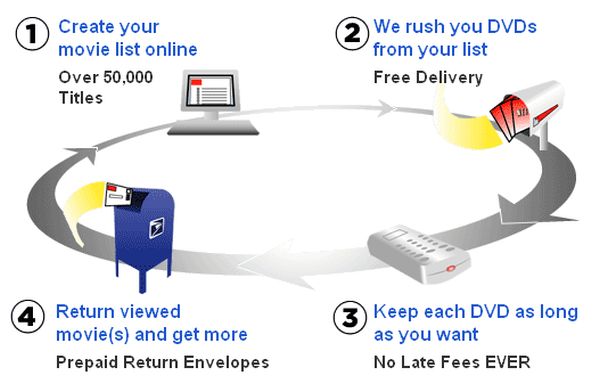Netflix Web Site and Envelope
The two most visible parts of the Netflix enterprise are the red mailing envelopes and the Web site. The patented envelope is essentially an ordinary mailing envelope with an extra long, removable flap. This extra length of paper is what lets DVDs make the round trip from the Netflix distribution center to your home in just one envelope. When the envelope travels to you, the flap displays your address while covering up the shipping center’s return address. You remove the flap when you seal the envelope to return it to Netflix, so only the shipping center’s address remains.
The envelope has been through several revisions as Netflix has refined its shipping methods and tried to become more profitable. These include the following:
- the addition of advertisements on the back of the flap
- the addition of a small slot that displays the barcode of the disc inside
- the removal of instructions on how to place the disc in the mailer
The Netflix Web site has been through numerous revisions as well. The company has made major changes to the site as often as every two weeks, constantly evaluating how the changes affect the business. Numerous features have come and gone, but for the most part, the site has looked a lot like other online retail stores. The available movies appear as thumbnail images, sometimes in conjunction with a brief description. When you hold your mouse pointer over a selection, the site pulls a lengthier description from a database and displays it on the screen. This description includes information about the movie’s plot, cast and MPAA rating. Clicking on a title takes you to a separate page with cast and crew information, technical specifications. Rating information from Common Sense Media, a separate company with its own Web site, is also displayed.
You can browse the section by genre, check out the Critic’s Picks and Award Winners, or use the Netflix Top 100 to decide which movies you want to see. You can also use the Friends feature to see what your friends are watching and compare which movies you like. When you find a movie you want to see, you add it to either your DVD or your Instant queue. If you want to see a movie that Netflix doesn’t have in its inventory yet, you can save it for later. Netflix ships DVDs in the order in which they appear in your DVD queue, and you can change the order or remove items in your queues as often as you want.
As you browse, you have three options for each movie you see on the site. You can give it a star rating, add it to one of your queues or tell Netflix that you’re not interested in it. The choices you make dramatically affect which movies Netflix features on the site when you visit. Next, we’ll take a look at the Netflix recommendation engine and how it works.
Netflix Theft
Netflix envelopes are solid red, so they stand out from the rest of the mail. This may make it easier for thieves to steal other people’s DVDs. In 2006, newspapers featured stories of postal employees borrowing or stealing hundreds of Netflix DVDs from customers on their routes. New York Magazine reported that a postal worker in Lyons, Colorado, stole 503 discs before being arrested.
Netflix Recommendations
The Netflix Web site makes these recommendations automatically using a recommendation algorithm. This algorithm instructs Netflix’s servers to process information from its databases to determine which movies a customer is likely to enjoy. The algorithm takes these factors into account:
- The films themselves, which are arranged as groups of common movies
- The customers’ ratings, rented movies and current queue
- The combined ratings of all Netflix users
The first algorithm behind these recommendation was called CineMatch. The CineMatch algorithm had a long run and proved fairly successful at predicting movies that subscribers would like. According to Netflix, these predictions were accurate within half a star 75 percent of the time, and half of Netflix users who rented CineMatch-recommended movies gave them a five-star rating.
Recognizing that there’s always a better way to do something, Netflix launched a contest in 2006 to find an algorithm that could beat CineMatch. The contest, called the Netflix Prize, promised $1 million to the first person or team to meet the accuracy goals for recommending movies based on users’ personal preferences. Netflix also released the test data for algorithm developers to follow: 100 million movie ratings, ranging from one to five stars, from anonymous users. Three years later, the $1 million prize was awarded to BellKor’s Pragmatic Chaos, a seven-member team which included two AT&T researchers. BellKor’s Pragmatic Chaos submitted its winning algorithm only 24 minutes before another team, The Ensemble. Each of these algorithm submissions demonstrated 10 percent improvement over CineMatch [sources: Netflix, Hoffman].
The recommendations system updates itself constantly, making thousands of recommendations every second based on more than 5 billion movie ratings. Netflix reports that the average Netflex user has rated about 200 movies, and new ratings come in at about 4 million per day. About 60 percent of Netflix subscribers select movies based on these recommendations. You can find these in the “Suggestions for You” section on the site, and you can refresh the suggestions as you rate more movies [source: Netflix].
Making good movie recommendations may seem like something that would require instinct or emotion. For example, if you recommend a movie you’ve seen to a friend, you take into account how the movie made you feel, your tastes and your friend’s tastes. Netflix recommendations, on the other hand, are all math. Netflix matches your viewing and rating history with people who have similar histories. It uses those similar profiles to predict which movies you are likely to enjoy. That’s what these recommendations really are — predictions of which movies you will like.
For more detail: How Netflix Works

